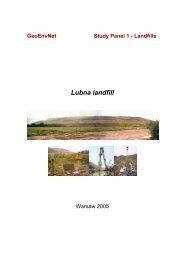ACTA SCIENTIARUM POLONORUM - SGGW
ACTA SCIENTIARUM POLONORUM - SGGW
ACTA SCIENTIARUM POLONORUM - SGGW
Create successful ePaper yourself
Turn your PDF publications into a flip-book with our unique Google optimized e-Paper software.
Economic Policy in Central Eastern Europe: Unit Root Consequences 61When the ‘Iron Curtain’ fell at the end of the 1980s, the nearby emergent CentralEuropean economies underwent economic liberalization stabilization, and privatization.By moving as quickly as possible towards the market economy, these societies wouldestablish the necessary framework for economic growth. Like their western counterparts,economic growth had not been as stable as might have been expected during the era ofsocialist planning – as for instance evidenced by the gluts of investments and unfinishedcapital projects that periodically occurred.However, questions can be raised as to the validity of the rationality approach. In otherwords: Does the evidence suggest that the outcomes for the Central European Economiespost 1989 have been as the classicals predicted in their rational world, or is ‘capitalismwisely managed’ the appropriate path for the authorities? The aim then of this study is toprovide a justification for certain economic policies with reference to Czech Republic,Slovakia, Poland, and Hungary (CEE 4). By investigating the GDPs and industrial productionindices for the CEE 4 economies, it can be determined whether these variablesare stable around their trends as the classicals proclaimed and thus state intervention isunnecessary. Any deviations will lead to appropriate changes in behaviour, which willrestore equilibrium. Alternatively, if GDP is unstable or stochastic, then the authoritiesmust take action to avoid permanent recessions.This study can be also regarded as an extension of unit root tests to the post communistcountries. It is worth to pointing out that these economies have some specific featuressuch as the specific structure of GDP, socio-economic environment, institutional and legalframework amongst others.Laissez – Faire: stable trending GDPThe classical economics presumes that the economy follows a trend determined bySolow’s neoclassical model [Solow 1956]. It assumes that the long-run component of theGDP is a deterministic trend with short-run fluctuations caused by external shocks. Therefore,Classical economics decomposes real GDP into a long-run trend and a short runstationary cyclical component. The slope of the trend is considered to be determined bylong-run factors such as technological growth, fertility, and educational attainment levels.Cyclical deviations from the trend are regarded as demand and supply shocks. Thesedeviations are temporary, which means that their fluctuations are eliminated through reversionto a long-run trend. The Classical economists state that over the long run, macroeconomicvariables grow at a constant trend and that any deviations from the trend areonly temporary and eventually eliminated by the invisible hand of market. Since thesedeviations are temporary, recessions do not have any permanent negative effects on GDPand there is no need for activist stabilization policy. The economy will converge to equilibriumrepresented by trend in long run.This belief in a deterministic trend is reflected in the common practice of detrendingmacroeconomic variables using a regression equation. In mathematical terms, classical economicspresumes that GDP is a trend stationary variable, which means that it is a sum of adeterministic trend and a stationary process. The GDP is a function of the time and somestationary cyclical component. This fact implies that GDP can be stationarized by estimatingand deducting of a trend only. The equation describing GDP can be written as followsOeconomia 10 (1) 2011
















